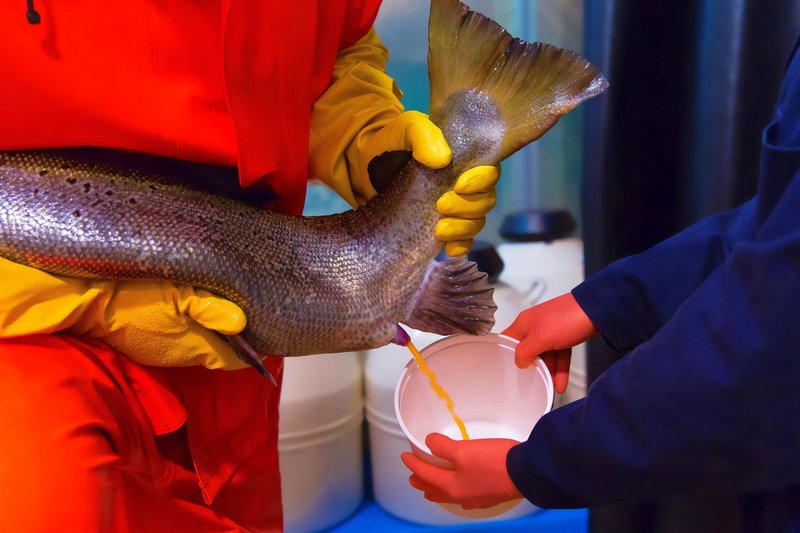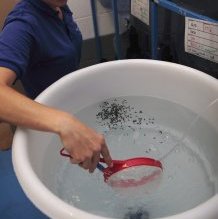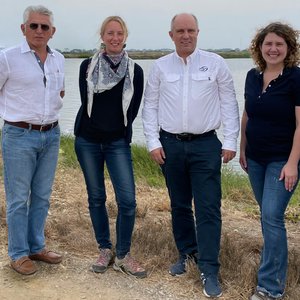AquaBounty’s goal has been to bring fresh salmon to the market in a responsible and sustainable way. Its story is well known. Back in 1989, researchers microinjected a growth hormone gene from Chinook salmon, coupled with a promoter sequence from an antifreeze protein gene from ocean pout, into fertilized Atlantic salmon eggs. It resulted in a salmon that grows faster to market size (4.5 kg in 18-20 months), compared to conventional farmed Atlantic salmon. More salmon can be produced in less time and use 25% less feed than other salmon. After a long process in receiving FDA approvals to raise genetically engineered (GE) salmon, AquaBounty now raises salmon in two land-based RAS farms, located in Albany, Indiana, United States and Rollo Bay, Prince Edward Island, Canada, and is building a new one in Pioneer, Ohio, United States.
Breeding programs
Research to improve salmon did not end in 1989, Alejandro Rojas, chief operating officer at AquaBounty, told Hatchery Feed & Management in a recent interview. Breeding programs are part of the current developments of the company. The main focus is better growth performance of the fish in RAS systems and flesh quality, in particular, flesh color. “We are running an operation in Indiana and our fish is a mix of eggs produced by conventional females mixed with GE neo-males in order to produce all-female transgenic fish,” Rojas added. The percentage of sterility reached by the company is 99.8%. “We could eventually reach 100% using new technologies that will be available in the market soon, together with gene-editing,” Rojas said.

AquaBounty broodstock.
Non-GE salmon
AquaBounty also delivers conventional non-GE Atlantic salmon eggs. The company breeds them separately, both in Prince Edward Island in Canada, but in separate facilities following FDA recommendations to breed them in different facilities in different locations.
“AquaBounty does not sell GE salmon eggs,” Alejandro clarified about the recent rejection of the project of American Aquafarms in Maine due to concerns about egg sourcing. “Any facility in the U.S. that farms GE salmon has to be approved by the FDA and American Aquafarms is not authorized. They never asked us for GE salmon,” Rojas said.
Alejandro also said that AquaBounty aims to become a supplier of non-GE Atlantic salmon eggs. The company is currently selling conventional Atlantic salmon eggs to small farms in Canada and is developing breeding programs for non-GE salmon with the same focus as the GE, which is for better growth performance in RAS systems and flesh quality.
RAS challenges and technology
As the company increases the scale of its RAS operations, challenges arise. Alejandro said that the first challenge is having the right workforce. “RAS technology is not new; it has been used for the past 20-30 years. But having people with the right experience and know-how is very important. Equally important is having a good quantity and quality of water.”
“The aquaculture sector in the U.S. is still small, considering the size of the RAS operations we are thinking of building. We have been in contact with technical institutes and universities, letting them know what kind of training profile we are looking for. We will also need to train our team members internally. It’s challenging. We need highly qualified staff, so we are also starting to look at countries with a more consolidated (salmon) aquaculture industry, such as Norway, Scotland, Chile and Canada,” Alejandro stated.

AquaBounty’s farm in Albany, Indiana, USA.
The RAS farm that the company is building in Ohio will be designed together with Innovasea. “We plan to build a state-of-the-art facility with the best technologies available in the market, not only from aquaculture but also from other industries which can be applied to our aquaculture business,” Rojas mentioned. “We are also assessing the best option for sludge treatment, whether it can be used as fertilizer or to produce energy. We are evaluating what can be done with the blood or offal and if we can incorporate this into the circular economy concept. And we are also considering plastic and styrofoam usage and how we optimize/reduce their use in our different operating stages and processes.”
The company is also testing RAS feeds. “The majority of our feeds are coming from Skretting and we are partnering with them to develop specific RAS feeds for our fish. The quality of the feeds and the water are the critical factors in a RAS system; therefore, we need quality RAS feeds,” Alejandro said.













